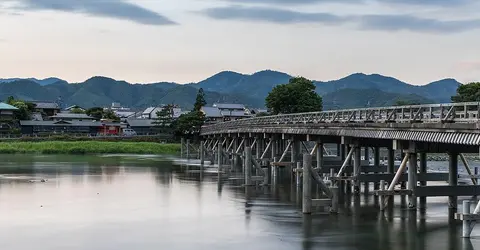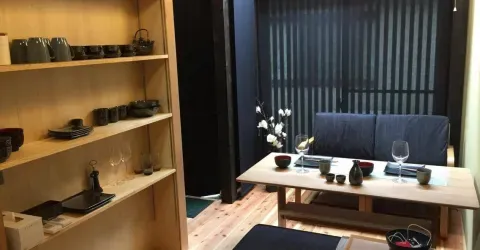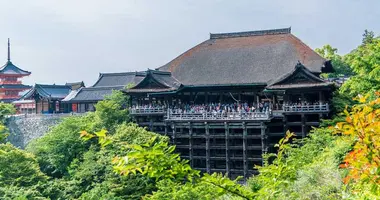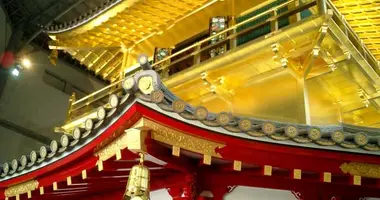The Arashiyama district in Kyoto
Excursions to Arashiyama, the "mountain of storms"
Located west of Kyoto, the small district of Arashiyama has gained great popularity with tourists. With the splendid banks of the Hozu River, its hills covered with maple trees, a bamboo grove, and its countless temples, unlike any other place... Arashiyama is a refreshing place of nature, to explore by foot through its timeless wonder.

Le pont Tokegutsu-kyo à Arashiyama
Wikimedia Commons
Arashiyama, nature near Kyoto
Arashiyama: the "mountain of storms", is not a fitting name. The district is nevertheless very calm, and constitutes a true ode to Nature. The beautiful Hozu river flows and meets the large Togetsukyo bridge, or "bridge under the moon". Across the bridge, the river takes the name of Katsura. The Togetsukyô offers a striking panorama of this Eden to the west of Kyoto. Twice a year, fleshy petals then tawny leaves descend from the hills planted with cherry trees and maple trees to speckle the dark waters of the Hozu-gawa, tearing the walkers away from the bridge of admiration sighs.
Arashiyama is a locality forming a district west of Kyoto. Far from the hustle and bustle of downtown Kyoto and the tall concrete buildings of the station, this area allows you to take a break and immerse yourself in the greenery. Many Kyotoites come to relax during the weekend to take a deep breath of fresh air while strolling under the magnificent foliage of Arashiyama.
Since the early years of the Heian period (794-1192), Arashiyama has been a walking area for the imperial court. Emperors and members of the nobility flocked to Arashiyama to celebrate hanami. This contemplation of cherry blossoms (sakura) or plum ( ume ) is a tradition dear to the Japanese. The burning of maple trees (momiji) in November is the occasion for a new aesthetic stir. The Togetsukyo bridge was also initially built at this time, in 836, but its current version dates from the 1930s.
- Read also: 5 places to admire the fall leaves in Kyoto
Many lords built their palaces and villas here. A success that has not been denied over the centuries, as evidenced by the magnificent Ôkôchi sansô by the great silent film actor OkochiI Denjiro (1898-1962).
What to see and do in Arashiyama?
The discovery of Arashiyama generally focuses on three main areas of interest: the bamboo grove, the Iwatayama monkey park, and the Tenryu-ji temple. Added to this is the unmissable walk along the western banks of the Hozu River. However, there is plenty of other temples, shrines, and of course, the bustling main street for shopping and bites to eat!
It is one of the most famous bamboo forests in the country. Access is free, and several paths wind between giant bamboos, which reach ten meters high. You can get there easily on foot from the neighboring Arashiyama or Saga stations, the location being well signposted.
Address : 68Susukinobaba-cho, Saga, Tenryuji, Ukyo-ku, Kyoto
- Related articles: 10 free things to do in Kyoto
This famous Buddhist temple is attached to the bamboo grove, so it is a good idea to kill two birds with one stone in a single visit. Belonging to the Rinzai Zen sect, Tenryu-ji has a sublime park, with a dry garden sublimating mosses and rocks, as well as a large pond opening onto the pine forest. The places are also listed as World Heritage by Unesco.
Address: 68 Susukinobaba-cho Saga, Tenryuji, Ukyo-ku, Kyoto
Hours: Open from 8:30 am to 5:30 pm (5 pm during winter)
Price: 500 yen ($4.50/3.75€)
Here is a rather rare experience: the visit of a park with monkeys, evolving in freedom. After a somewhat sporty climb of about twenty minutes to reach the top of Iwata hill, you will discover a platform offering on the one hand a beautiful view of Kyoto, but also a playground for monkeys. It is also possible to enter a small hut with netting, to feed the monkeys who remain in their natural habitat.
Address: 8 Gennrokuyamacho, Nishikyo-ku, Kyoto
Hours: Open from 9 am to 5 pm
Price: 550 yen ($4.50/3.75€)
Découvrez Arashiyama avec un guide !
Other activities
During the day, cross the Togetsukyo Bridge to reach the South Rim. Then go back west, on the path along the water. This short walk allows you to admire the hills covered with trees and the emerald waters of the river. Particularly recommended during the koyo (fall foliage) in November, to enjoy the red and yellow foliage of hundreds of maples...
Finally, after dark and the colors soar, Arashiyama has new delights in store for visitors. The refined cuisine served at the Nishiki, a luxurious and traditional restaurant on an islet in the Hozu River, awakens the taste buds. In December, the Hanatôro festival, or " lantern festival", sublimates the neighborhood with a flute tune. A dream to be lived with your eyes wide open.
Note that it is also possible to take a boat trip down the Hozu river, but also to go up the gorges of the river aboard the Sagano Romantic Train.
- Read also: Descent of the Hozu river in Arashiyama
How to get to Arashiyama from Kyoto?
The Arashiyama district is very close and easily accessible from various points of Kyoto, especially from the train station and the city center around Kawaramachi. You can expect around 30 min for the journey.
From downtown Kyoto, the easiest (and most enjoyable) way is probably to take the charming little Randen tram from Shijo-Omiya station in central Kyoto. One way will cost you 220 yen ($4.50/3.25€).
On the train, the Sagano line, as well as the San-In line (which leaves from Kyoto station) will take you to Saga-Arashiyama station. You can also take the Hankyu Line to get to Hankyu Arashiyama Station, which is on the other side, not far from the Monkey Park. You will then need ten to fifteen minutes of walking.
If you prefer the bus, lines 11, 28, and 93 stop in central Arashiyama, at the Arashiyama Tenryuju-mae stop. They serve the largest districts of Kyoto such as Kawaramachi or Karasuma.
Read also: Public transport and its prices in Kyoto
Address, timetable & access
Address
Timetable
Randen, Sagano, San-in and Hankyu lines. Bus lines 11, 28, 93.









































